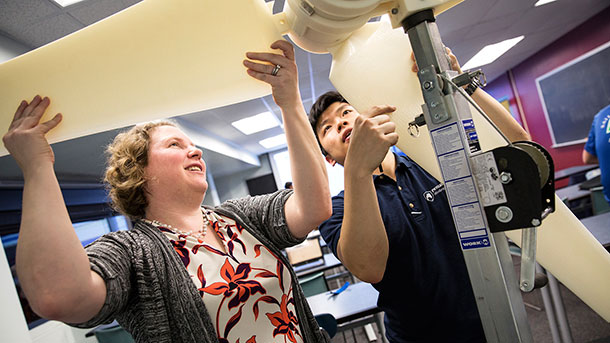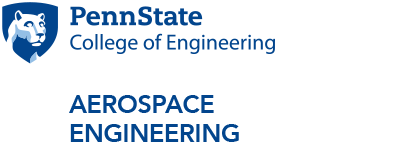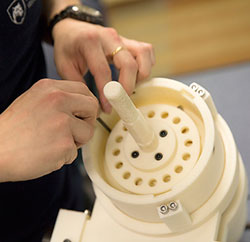
Susan Stewart, lead strategic adviser of the Wind Energy Club and senior research associate and associate professor of aerospace engineering, and Chee Hau Teoh, a junior in mechanical and nuclear engineering, attach blades to the tower of a small-scale wind turbine prototype built for demonstration purposes.
Transforming the power of young minds
Wind Energy Club secures funding to educate secondary school students on wind energy
05/18/2017
The wind keeps picking up for the Penn State Wind Energy Club—and continues to blow in the right direction.
Hot on the heels of its victory at the U.S. Department of Energy Collegiate Wind Competition 2016, the club was looking for a new hands-on activity—one that could not only help build team members’ skills for the next competition and recruit new members, but also incorporate educational and outreach activities for K-12 students.
The club found the perfect opportunity in the form of an E2 Energy to Educate Grant awarded by Constellation, an Exelon company. The $9,250 the club recently received will allow its members to design, test, and manufacture an interactive, portable wind turbine used to educate high school students about wind energy and explore novel science, technology, engineering, and math (STEM) concepts.
“It’s our job to help promote the future of renewable energy now,” said Mitch Proulx, president of the Wind Energy Club and a mechanical engineering senior. “In 10 years, it will be this younger generation entering the industry when wind is fully in the mainstream energy market. It’s important to inspire and educate students today for a better tomorrow.”
Under the guidance of Susan Stewart, the club’s lead strategic adviser and senior research associate and associate professor of aerospace engineering, and in partnership with the Pennsylvania Wind for Schools (WfS) Program and the Penn State Center for Science and the Schools, club members will visit Mifflin County High School (MCHS) in Lewistown, PA, in spring 2017 to conduct hands-on educational activities with 35 high school students.
Prior to the event, students will participate in a two-week wind energy lesson conducted by MCHS on the basics of wind energy to better prepare them for the club’s visit. A smaller group of environmental science students is collaborating with the club’s education team to help finalize activities and desired outcomes.
“Having the students involved in the planning process helps focus our efforts on activities that are interesting to them and that will be most impactful,” said Rachel Duffy, education team leader and an energy engineering senior. “It also helps increase their knowledge of wind energy and hopefully, their enthusiasm for it, too!”
During the one-day event, the students will have the opportunity to apply the knowledge gained from their two-week wind lesson by observing wind speed; recording and interpreting various data including voltage, power, and cumulative energy; and performing their own calculations.
In addition to providing interactive activities, the club will also teach the students about STEM majors and career paths available within the wind industry.
The club is currently building a 3’-6’-diameter turbine on a 13’ tower. The team will also design and build its own blades, manufacture the nacelle in Penn State’s Learning Factory, and test the turbine outdoors on the University Park campus. The blades will be designed for low wind speeds to ensure the activity is successful even in five mph wind speeds, and real-time data will be available on a laptop for students to see how much power the turbine produces.
The turbine design will have its foundation in the club’s previous experiences with designing and building a fully operational wind turbine for the Collegiate Wind Competition.
With education and outreach activities now part of the club’s mission, the club hopes the success of this project will help develop sustainable connections with the WfS Program that will allow members to continue visiting schools in the future and reach its goal of impacting approximately 250 secondary school students during the 2017-2018 academic year.
The value of this project also extends beyond secondary school outreach. The design and construction of the turbine, as well as tackling the challenges of planning and managing a project, provide an invaluable educational opportunity for the Wind Energy Club members, who are enrolled in various majors at the University. The hands-on experience gained outside of the classroom will also benefit members who aspire to enter the wind energy industry.
The turbine and its design will also increase student involvement in the club and enhance its value, helping to attract new members, which will be essential to the sustainability of the outreach program to secondary schools and in providing equivalent outreach opportunities to the Penn State student body.
Penn State was one of 17 projects in 2016 to receive funding from the Constellation E2 Energy to Educate Grants program. More than $380,000 was awarded to the projects which will reach more than 35,000 students nationwide, grades 6 through college.




